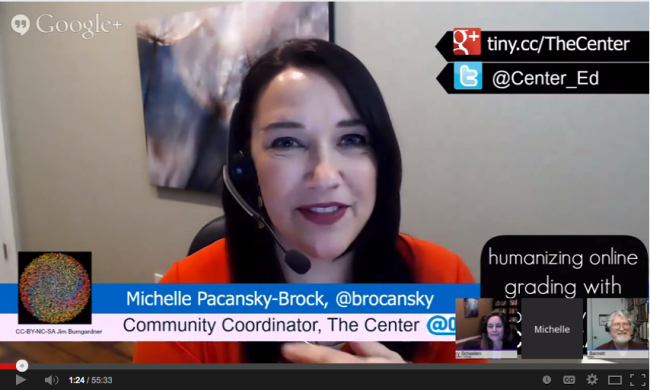You have /5 articles left.
Sign up for a free account or log in.

Michelle Pacansky-Brock conducting an online session with instructors.
California State University-Channel Islands
Ten years ago, when Michelle Pacansky-Brock was teaching face-to-face art history courses, she began using digital technologies that she thought could help boost student outcomes. Now she’s giving keynote speeches and other presentations around the country to hundreds of educators about why it’s important to employ web-based tools -- mostly free and relatively easy to use -- in online and residential courses and how to teach effectively with them.
The author of a newly released book, Best Practices for Teaching With Emerging Technologies (Routledge), Pacansky-Brock believes educators need to understand the applicability of Web 2.0 technologies, not just for distance education but for all types of learning environments.
The first edition was published in 2012, but technologies change so rapidly that the author, who recently became faculty mentor for digital innovation for two programs of the California Community Colleges system, told “Inside Digital Learning” that the book was outdated the minute it was printed. She noted that it was bit odd to print a book about technologies rather than publishing it in a digital format, but she realized the value of a physical guide that educators can reference easily. (In an arrangement with the publisher, 50 percent of each chapter in the updated book is shared online with a CC-BY-NC license for free download.)
Pacansky-Brock, previously innovations lead at California State University Channel Islands, also said the original version needed refreshing due to the high failure rates of ed-tech start-ups, the vast use of smartphones and social media, the expansion of learning management systems, and the increased adoption of open educational resources.
While she sees a crucial role for technology in the learning process, she believes even more strongly in the centrality of instructors themselves. “We are in the midst of the greatest learning revolution in history,” Pacansky-Brock wrote on her website. “Technology will continue to enable a future where learning is inclusive and accessible to all, but teachers -- not tools -- will fuel this shift.”
 In the second edition of Teaching With Emerging Technologies, the author provides practical examples of how low-cost and free technologies can support learning, and best practices for integrating web-based tools into a course management system. (The book is written in easy-to-digest chapters that include sidebars and spotlights about how professors from a variety of institutions are using tech tools effectively.)
In the second edition of Teaching With Emerging Technologies, the author provides practical examples of how low-cost and free technologies can support learning, and best practices for integrating web-based tools into a course management system. (The book is written in easy-to-digest chapters that include sidebars and spotlights about how professors from a variety of institutions are using tech tools effectively.)
In a phone interview, Pacansky-Brock responded to questions about her updated book.
Q: What technology has had the biggest impact on teaching and learning in higher education during the past decade?
A: The creation of smart mobile devices was mind-blowing. Some of the data I mention in the intro of the book shows that one-half of third graders and 90 percent of high schoolers use smartphones. It’s not just about communication; smartphones are what they use to connect and share their experiences.
Q: Because most college students have smartphones, how can instructors utilize mobile technology in their face-to-face courses?
A: There are faculty who have ardent views that students should not use smartphones in the classroom. But when students have a meaningful experience, they will take a picture and tell someone about it. When you create a learning environment in which devices are OK, then you are going to use them as a learning tool.
Just after the iPhone came out, I was teaching a history of women in art course. Very few women are remembered in art history, so during class, I asked students to call three people and ask them for the names of three artists. As a class, we discussed their findings, which, to no surprise, included few women. Using phones created a more meaningful way of finding the information. It was active learning, and students remembered more. I bet that my students still remember that moment.
Q: In the book, you write about using technology to move toward participatory pedagogy. What do you mean and why is it important?
A: I’m talking about moving the instructional paradigm to the learning paradigm, as outlined in the Barr and Tagg article [“From Teaching to Learning” by Robert B. Barr and John Tagg]. If we look at higher education, the mainstream approach is still anchored in the instructional model. With the learning paradigm, the learner is at the center. This involves giving up control and invites students to figure out things for themselves. We need to move closer to the learning paradigm.
But you need to have a process in place. You say, "This is what I want for my students, but the tools I’m using aren’t working." Often faculty who don’t want to use technology are afraid they’ll be vulnerable. If they don’t know how to use the technology, that’s OK if they just acknowledge that.
Q: Is there a risk associated with using certain web-based technologies?
A: When I wrote the first edition, everything I was using was a “freemium” model, so a lot of the tools didn’t [survive]. The market has matured a bit. There is more recognition that companies need to figure out a business model that makes sense. There still are some free options, and they could always go away, but that risk is reduced. I have more confidence that the tools I wrote about will be around a bit.
We also know that half of faculty that teach are not full-time faculty. Many don't know what is available at their institutions. But now you can go out and try things on the internet for free. The nature of technology has changed so much.
Q: What technologies do you recommend for instructors to effectively engage and communicate with online learners?
A: Audio, video, images and mobile devices are the 21st-century palette. When students sit in front of a computer to learn, they will be more engaged and more motivated when they can see you, hear you and have options to learn from anywhere.
Q: You talk a lot about “humanizing” the online class environment in your book. What do you mean by that?
A: When I was at CSU Channel Islands, I facilitated an online teaching program for faculty. Many faculty who participate in the program feel skeptical about the quality of online learning -- not because they are concerned about the content, but because they’re concerned about what will happen to their classes if they aren’t present. In the course, they engage with their peers in asynchronous video conversation using VoiceThread, create a one-minute course bumper video using Adobe Spark Video, and embed that video in a website.
By the time the course is over, faculty have moved out of their comfort zones and overcome the anxiety that often comes along with speaking into a webcam. Through the process, they’re reminded that they are not perfect, and their flaws are what make them wonderful and special to their students. They make mistakes and learn the world doesn’t stop if they screw up.
Q: Why is it so important for instructors to teach with digital technologies?
A: I think there are a lot [of instructors] who have a sense of allegiance to not using a lot of technology. They are straddling the middle chasm. I think the chasm is huge and it is the sweet spot in higher education right now.
We need to encourage the new era we are in. As they graduate, students will be expected to have an online presence that demonstrates how they are unique. The last chapter of the book asks a very provocative question: Are we shaping our students for personal and professional success?
Giving students and faculty a place on the web is powerful, but it is messy, especially when we are supposed to demonstrate [return on investment] on everything we do. But how can we expect students to have the tools if the faculty don’t have the skills?
My participation with technology as a blogger, on Twitter and building my own personal online network has influenced me. The more we share and participate, the more we are touching people. It is a real responsibility for instructors is to model and share [technologies] with our students.








